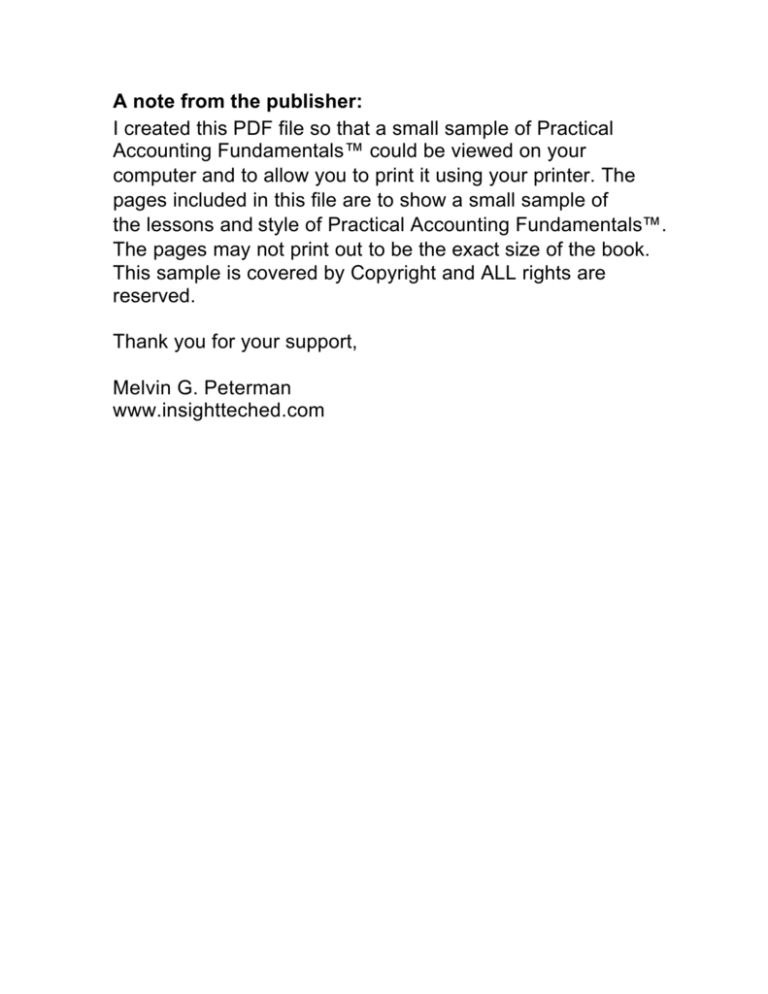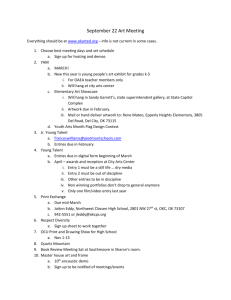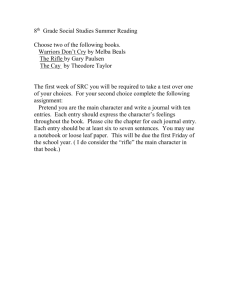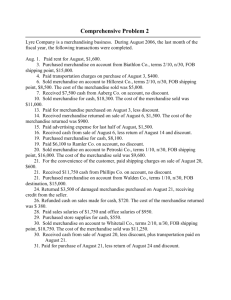
A note from the publisher:
I created this PDF file so that a small sample of Practical
Accounting Fundamentals™ could be viewed on your
computer and to allow you to print it using your printer. The
pages included in this file are to show a small sample of
the lessons and style of Practical Accounting Fundamentals™.
The pages may not print out to be the exact size of the book.
This sample is covered by Copyright and ALL rights are
reserved.
Thank you for your support,
Melvin G. Peterman
www.insightteched.com
Practical Accounting
Fundamentals
SAMPLE
ONLY
TM
DO NOT
REPRODUCE
Melvin G. Peterman
TM
TM
INSIGHT TECHNICAL EDUCATION
Written by Lori Peterman
Contents
SAMPLE ONLY
1DO NOT
13
REPRODUCE
2
17
3
21
4
23
5
25
6
27
7
31
Test 1
37
8
39
9
43
Forward
Introduction
What is Accounting?
Accounting vs. bookkeeping
GAAP
Technology
The Balance Sheet
Financial statements
Assets
Equities
The Income Statement
Net income
Revenue
Statement of Retained Earnings
Retained earnings
Dividends
Statement of Cash Flow
Cash flow
Dividends
Equity accounts
Transactions
Information system
Transactions
Assets
Journal Entries & Accounts
Accounts
Debit / Credit
Journal entries
For chapters 1 - 7
Chart of Accounts
Account categories
Typical accounts
Posting to the Ledger
Transactions
Ledger
Trial balance
10
Income Determination
SAMPLE ONLY
51
11
DO NOT 59
12 REPRODUCE
67
13
75
14
79
15
85
Test 2
89
16
91
17
97
18
101
19
105
Periodic Financial Statements
Fiscal Period Assumption
Revenue Recognition & Matching Assumptions
Adjusting Entries
Depreciation
Nonoperating items
Extraordinary items
Closing Entries
Closing Entries
Worksheets
Accounting cycle
Accrual vs. Cash Accounting
Cash basis accounting
Net cash flow
Cash
Cash
Petty cash
Bank accounts & reconciliations
Marketable Securities
Marketable securities
Dividends & interest
Valuations of marketable securities
For chapters 1 - 15 with a focus on
chapters 8 - 15
Receivables
Discounts & returns
Credit balance receivables
Bad debts
Payables
Accounts payable
Gross method of purchase discounts
Net method of purchase discounts
Inventory
Inventory methods
Long-lived Assets
Valuation of property, plant, & equipment
20
Other Forms of Business
SAMPLE ONLY109
21DO NOT
115
Test 3
REPRODUCE
119
Sole proprietorship
Partnership
Limited Liability Company (LLC)
Payroll
Payroll register
Employer taxes
End of period adjustments
Final test for chapters 1 - 21
Answer key
Answer key for excercises & test
Resources
Answer key for excercises & test
Index
123
169
170
2
SAMPLE ONLY
The Balance Sheet
DO NOT
REPRODUCE
Whenever you are asked if you can do a job, tell ‘em,
“Certainly, I can!” Then get busy and find out how to do it.
~ Theodore Roosevelt
In this chapter, and the next three, there will be an example of a financial statement along with some
explanation and definitions to get you started. We will assume that the companies we will be talking about are
corporations. In Chapter 20, we will discuss the various forms of business that are commonly found and the
differences in accounting for them. We will use the ABC Supply Company’s financial statements for the year
2002 for these four chapters.
Here is an example of a balance sheet. The current assets are totaled and then added to the total of the longterm assets to give us total assets. Likewise, the current liabilities are totaled and added to the total of the
stockholders’ equity to give us total equities. Total equities and total assets should be equal.
ABC Supply Company
Balance Sheet
December 31, 2002
Assets
Current assets:
Cash
Accounts receivable
Inventory
$13,000
9,500
10,000
Long-term investment:
Investment in land
Equities
Current liabilities:
Accounts payable
Salaries payable
$15,500
3,000
$18,500
$32,500
15,000
$47,500
Stockholders’ equity:
Capital stock, 2700 shares
issued & outstanding
$27,000
Retained earnings
2,000
29,000
$47,500
It is customary to put a dollar sign beside the first amount in each column and beside an amount appearing
below an underline. It is also customary to list detail figures in a column with the total to the right of the last
item. Final totals are double underlined.
The balance sheet shows a picture of the business at a particular moment in time. It tells you what the assets
of the business are, its liabilities, and the owners’ (stockholders’) equity. The balance sheet is always “in
balance”, i.e., the assets always equal the equities.
Assets
Let’s discuss the elements of the balance sheet. Assets are future economic benefits that the business owns the
rights to. Assets are considered to provide future economic benefits for a number of reasons, which include
the following:
1.
2.
3.
4.
The asset may have purchasing power. Cash is an example; other assets may be acquired with it.
The asset is a claim for money. Accounts receivable is an example.
The asset can be sold in order to gain cash. Merchandise inventory is an example.
The asset offers potential services. Buildings, land, machinery, and equipment are examples.
The primary asset categories are:
Current assets
Long-term investments
Property, plant, and equipment
Intangible assets
Other assets
The Balance Sheet
17
Exercises - 7
Questions:
SAMPLE ONLY
DO NOT
REPRODUCE
1. What is a journal entry?
2. What is a compound journal entry?
3. What is an account?
4. What is a ledger?
5. What are debits and credits?
6. What accounts normally carry a debit balance?
7. What accounts normally carry a credit balance?
8. What is double-entry accounting?
Problems:
A. Journalize the following transactions.
1.
2.
3.
4.
5.
6.
Purchased merchandise on account for $65,000.
Made cash sales of $70,000.
Cost of goods sold in #2 was $42,000.
Spend $3,500 on miscellaneous expenses.
Paid salaries of $20,000.
Paid $30,000 on account.
B. Journalize the following transactions for the Smiling Onion Company (you may use whatever dates you
choose – as long as they’re all in the same year!):
1. Issued capital stock for cash of $90,000.
2. Purchased merchandise for $8,000 cash.
3. Made cash sales of $14,000.
4. The cost of the goods sold in #3 was $5,500.
5. Purchased merchandise on account for $80,000.
6. Spent $1,500 on advertising.
7. Sold merchandise on account for $110,000.
8. The cost of the goods sold in #7 was $60,000.
9. Paid rent of $7,500.
10. Paid salaries of $16,000.
11. Received payment from customers for $80,000.
12. Paid $20,000 in cash for land.
13. Salaries owed at the end of the year were $5,000.
14. Paid dividends of $2,500.
Journal Entries & Accounts
35










